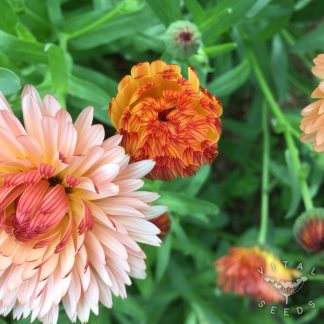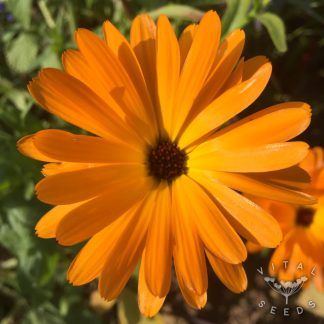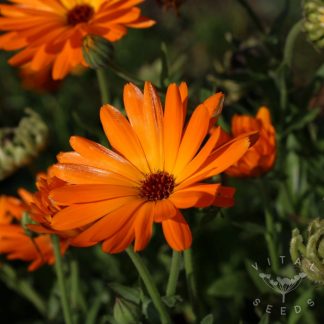Calendula Seeds
How to grow calendula
How to grow calendula
Seed Sowing
Calendula is a hardy annual that can be sown in September to overwinter for early blooms in spring or from March to May. Sow seeds either in modules or direct 1 cm deep in rows around 30 cm apart.
Transplanting
Ensure your seedbed is free from weeds; sheltered sunny sites are best, they will tolerate some shade. Can be grown between taller plants and edges of beds to attract beneficial insects. They do prefer poor, free-draining soils.
Plant Care
Keep weed-free and watered during hot spells. You can mulch around the plants to keep in moisture and prevent weeds. Deadhead to prolong flowering and pinch out to create more bushy growth.
Challenges
Aphids like the flowering plants, but predatory insects easily find them on these bright blooms. Powdery mildew can also be an issue; avoid watering in the evening. Water the soil, not the plants and ensure there is enough airflow by not overcrowding.
Harvest
Pick the flower heads often to encourage more flowers to form; they should keep flowering well into autumn. Pluck off the petals and use fresh or dry for later use.
Culinary Ideas
Nothing is better than a sprinkle of bright petals on a salad; calendula has a mild flavor. They are a good source of vitamin A and C, can be used to decorate cakes, added to summer rolls, stirred into cooked rice, and overall make a great garnish. Dried petals can be added to herbal teas or used to make tinctures and balms.
Seed Saving
Calendulas will self seed in situ if left to flower and set seed. You will see the curved spiky tusk like seeds turn from bright green to brown; seeds vary in size and shade. Once the seed heads are brown, you can collect the whole heads to dry indoors for a few days before rubbing and separating the seeds from the chaff before storing in a cool, dry place.
Showing all 3 results
-


Calendula – Triangle Flashback / Zeolights (Organic)
£2.58 Add to basketCalendula – Triangle Flashback / Zeolights (Organic)
A stunning version of the regular calendula with fully doubled blooms and of peach, gold and bronze petal colour. This calendula variety is a real treasure. Pastel shades of orange, pink and peach are tinged with yellow towards the petal base. The backs of the petals are maroon. A pure joy to look at. We were so excited to have found this strain of calendula, bred by Frank Morton from Wild Garden Seeds in Oregon, USA. The flowers don’t only look good in the garden or as cut flower, they are also edible and can be used for medicinal purposes, too. An abundance of beauty for your garden!
(Approximate seed count – 80) £2.58
£2.58 -


Calendula – Orange (Organic)
Price range: £2.28 through £3.90 Add to basket This product has multiple variants. The options may be chosen on the product pageCalendula – Orange (Organic)
Also known as ‘Pot Marigold’. This is the classic calendula, producing abundant large orange blooms over a long season. We love calendula and would never go a season without it. It is really easy to grow and loved by humans and insects alike. There is something magical about finding bumblebees sleeping in calendula flowers early in the morning. The flowers are edible and make a great addition to salads. The petals have good medicinal properties and can be taken as an infusion in hot water or turned into a powerful tincture. Calendula’s medicinal actions include but are not limited to: anti-inflamatory, astringent, vulnery, and anti-microbial.
(Approximate seed count – 125)
 Price range: £2.28 through £3.90
Price range: £2.28 through £3.90 -


Calendula – Ivory Princess (Organic)
£2.50 Add to basketCalendula – Ivory Princess (Organic)
Large double and semi-double creamy-yellow blooms with a contrasting dark centre disk. This is a wonderful new addition to our catalogue for 2024, we have totally fallen in love with this variety. The delicate and contrasting colours make it a superb addition to the garden and it looks wonderful in bouquets.
Its long stem length compared to other calendulas we’ve grown make it particularly suitable as a cut flower.
(Approximate seed count – 100)£2.50
Showing all 3 results






